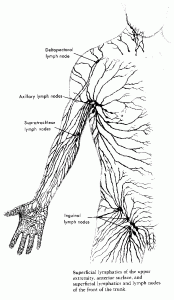Does this scenario make you uncomfortable? We’ve all been there. You know that frustration. Now imagine that same traffic jam occurring INSIDE your body. This, my friends, is Lymphedema.
So what is Lymphedema?
Much like traffic backing up due to a highway being shut down, Lymphedema is fluid backing up as a result of lymphatic pathways being shut down. Although in rare circumstances someone could potentially be born this way, the most common cause of Lymphedema you’ll see is when a normal lymphatic system becomes altered by medical intervention. The number one cause of Lymphedema in the United States is surgical intervention or radiation treatments to combat cancer.
Exactly how does lymphedema occur?
Well, think of your lymphatic system as a major highway system. In Indianapolis, IN, consider I-465. If someone removed several lanes on I-465, well then traveling becomes difficult if not impossible. Your body is a road map of sorts as well.
Brace yourself for a layman’s anatomy snippet! Inhale, exhale. Ok? Here we go.
 Imagine drawing a cross on your body that divides it down the middle to create two halves. Now draw another line perpendicular to the first at your waist. This divides your body into four sections or “quadrants”. Each of these quadrants has a major receiving station – an armpit (axilla) or bikini line (groin). Just under your skin in each quadrant are several “highways” (vessels) of fluid traveling to eventually dump into the axilla or groin of its quadrant. This is a basic “traffic pattern” of your superficial lymphatic system.
Imagine drawing a cross on your body that divides it down the middle to create two halves. Now draw another line perpendicular to the first at your waist. This divides your body into four sections or “quadrants”. Each of these quadrants has a major receiving station – an armpit (axilla) or bikini line (groin). Just under your skin in each quadrant are several “highways” (vessels) of fluid traveling to eventually dump into the axilla or groin of its quadrant. This is a basic “traffic pattern” of your superficial lymphatic system.
If something were to happen to scar or remove one of these major receiving areas, then you would have an “orange barrel” scenario. In the fight against cancer, surgery is used to remove nodes or radiation treatments obliterate healthy tissue along with cancer cells. Both treatments create scaring that impedes lymphatic flow or possibly even removes an entire section of lymphatic highway that can’t be rebuilt. In the case of damage to the axillary (armpit) region, this leaves the arm, chest & back with no highway lanes in which to evacuate fluid. The result? The area becomes just like you stuck in traffic having quaffed down an entire Big Gulp. All full of fluid the pressure begins to mount and the limb or thorax (or both!) begins to swell. This build up becomes very uncomfortable and there is no apparent way to get rid of it.
It’s very easy for the person to deny Lymphedema is actually happening because, in many cases, the swelling happens slowly and over time. It’s very difficult for the person to accept that the body may no longer be capable of finding a way to evacuate fluid. This becomes a potentially dangerous form of denial because the longer the person waits to help their system find a “detour,” the more complications can arise.
Just like the fish tank that doesn’t get cleaned, the fluid in a limb that is swelling due to a blocked lymphatic system begins to turn toxic. This toxicity leads to tissue break down within the area that is swelling. The area becomes hot and engorged and risks sores or infections developing from the inside. Exteriorly, a simple cut can abscess quickly because the area is already toxic underneath. In extreme cases, the swelling can be so challenging for the body that the fluid will actually weep through the skin.
At this point, this situation is extremely difficult to deal with. The client has to undergo a series of meticulous compression wrappings to reduce the size of the limb. Not only is this uncomfortable and inconvenient, it can be quite costly to the patient.

So now what? How do you fix it?!?
Well, what do you do when the road is closed on I-465? You take a detour or are “re-routed” by some nice guy in a bright yellow vest. In the case of a compromised lymphatic system, I get to be the guy in the yellow vest. Through a series of treatments, the body can be taught alternate routes to move fluid where it needs to go. If the client receives treatment soon after the pathways have been altered, the odds of swelling decrease significantly.
Unfortunately, many patients do not pursue preventative Lymphedema treatments simply because they don’t get the guidance they need to do so. The medical community and insurance companies often times have little idea how to deal with Lymphedema, who to refer to, and what constitutes adequate treatment to correct the problem.
Physicians are beginning to get on board in that they are more than willing to write the prescription for treatment when the patient requests it. Many times, however, the doctor’s duty stops after the cancer has been removed. This is understandable as Lymphedema is an area of expertise all its own. One shouldn’t expect the doctor to be able to speak in detail regarding this. Unfortunately, because of this limitation, the patient is left to research finding treatment on her own. In addition, if the need for preventative lymphedema treatment is not stressed following surgery, the patient may be grossly unaware how severe the problem could become if neglected.
As for the insurance companies, they may pay for treatment but THEY DO NOT POLICE THE PEOPLE THEY PAY TO TREAT THE CLIENT. I have seen Lymphedema cases exacerbated by the very therapist the insurance company will reimburse but who has absolutely no business treating such a case! This is because the insurance company has decided that the only therapists they will pay to treat lymphedema are physical therapists, nurses or physicians. They assume the medical credential automatically covers the training required. Not so. The fact is that unless one of these people works in an actual Lymphedema clinic, rarely will you find someone with those credentials who is adequately trained in true Lymphedema therapy. Once the insurance runs out, the client is left worse off than they began. Then begins the merry go round of the client needs help but can’t afford it.
I stand on my soap box with this because this doesn’t have to be the case. These people need to know that the doctors do not necessarily know where to refer for treatment AND that the insurance companies do not necessarily know if the therapist they cover is qualified to help!!!!
If you or someone you know has experienced cancer treatments, please know and share this information. There is no reason you, your friend, family member or co-worker should ever have to endure the worst case scenario.
This is what you should know:
1. Immediately after the physician releases the patient, that person should be receiving lymphatic work to help the body detour or re-route fluid. Once the body is assisted with the re-route, the odds of swelling decrease significantly.
2. Find a QUALIFIED practitioner. (Especially if the problem is an existing Lymphedema requiring reduction!!!) LANA (Lymphology Association of Northern America https://www.clt-lana.org) is an excellent place to start to find someone qualified. LANA certified therapists required to have received extensive training and are retested at regular intervals to verify skill level.
3. If you can’t find a LANA certified practitioner, ask the therapist you choose what kind of training she has received to treat Lymphedema. A BASIC MASSAGE or PT COURSE TRAINING IS NOT ACCEPTABLE. Your therapist should have been trained in a system such as Vodder, Földi, Casley-Smith, Guenter Klose, or Chikly. If you require treatment to achieve a Lymphedema reduction, the therapist must be MLD/CDT (Manual Lymphatic Drainage/Combined Decompressive Therapy) certified.
As for me, I have been through Chikly’s certification training and was certified to treat Lymphedema. Although I no longer hold the certification, I am still qualified to treat post-operative clients, clients who have never experienced swelling, clients who are just beginning to experience swelling, or clients who have received reduction from swelling and are working to maintain their reductions. Outside of these, I help folks find the person they need to treat them safely.
I know this doesn’t sound pretty but the fact that Lymphedema is reversible as well as preventable by the right therapist. Recovery from cancer is difficult enough without having to deal with the side effects of inadequate or inappropriate treatment. Now, after reading this blog, you are empowered to help yourself or someone else and that is a huge step in the battle against Lymphedema. Please spread the word? The person you help will thank you.


0 Comments